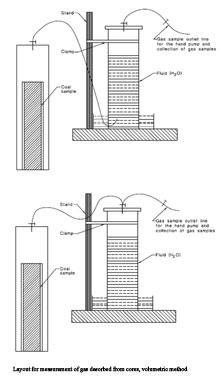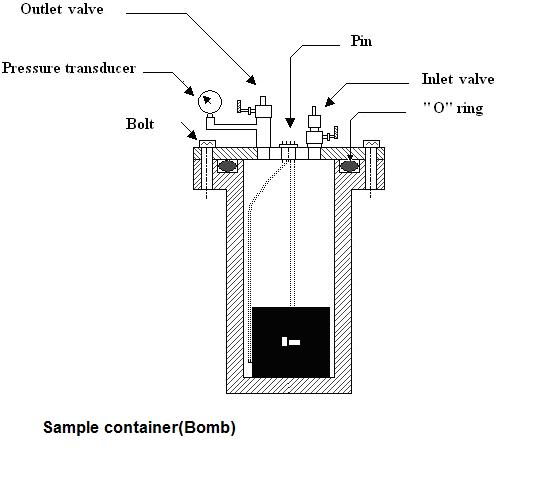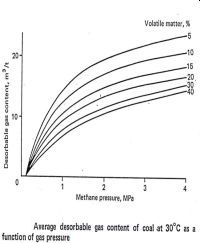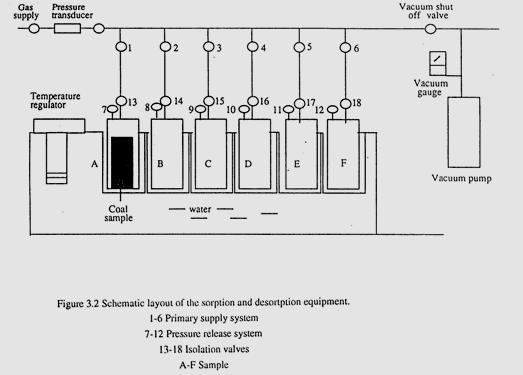Factors – Gas
Factors 0 CommentThe most important factors associated with the gas environment in an outburst prone region are the seam gas pressure, gas permeability and the gas content and composition. Mining operations promote the change of methane into a fully gas state and the resultant increase in gas pressure triggers the outburst. Therefore, mines take the position of monitoring gas pressure to avoid build-up. However, it is easier to monitor the gas content of the coal and use this value to obtain gas pressure (see following graph). In Australia, the critical value of gas content for outbursting with carbon dioxide is 6 – 7 m3/t.
The gas content in a seam is a major factor to consider when looking at outbursts. It affects the probability of an outburst and also the size of an outburst should one occur. A calculated estimation of the content of gas must be made in order to assess the mine ventilation requirements, drainage estimation and the drainage system design. The following pages discuss methods of estimating the content of gas in a particular region of a coal seam.


DIRECT ESTIMATION
- Direct method
INDIRECT ESTIMATION
- Analytical Method
- Volumetric Method
- Gravimetric Method
PROBABILITY ESTIMATION
- Probabilistic Method
Gas content: direct method
The direct method of estimating the content of gas in a body of coal consists of drilling a core sample from an area of the coal seam and enclosing this sample as quickly as possible in an airtight bomb. It is customary to use the full length of the core sample as variations can occur depending on the quality of the coal seam. The coal bomb is then connected to a water displacement apparatus and the quantity of gas released with time is measured and recorded as Q2. This method is continued until the gas emitted from the sample is less than 0.05 cm3/gram per day for five consecutive days (McCulloch et al, 1975) or the gas emitted is less than 10 cm3/day for seven consecutive days (Diamond & Levine, 1981).
After the gas emission has reduced to the required rates, the mass of the sample is measured and the sample is placed once again in a sealed bomb and crushed using steel rods or balls to release any remaining gas. This gas is measured once again using the water displacement method and the quantity is measured and recorded as Q3.
To account for the quantity of gas lost between drawing the sample from the coal seam and placing the sample in the sealed bomb, the results of gas emitted vs. the square root of time are plotted on a graph. By making the assumption that gas release follows the square root law, the release at time zero can be found by extrapolating the other results. Q1 can then be found by noting the time taken to seal the sample in the bomb and recording the gas content. The lost time should be taken as from the start of drilling to the time of sealing in a horizontal drill hole, or for vertical drill holes lost time is the time taken for the pressure in the core to equal the hydraulic head.
The total gas content of the sample can be calculated as
Q = Q1 + Q2 + Q3


Gas Content: Analytical Method
The Analytical method is known as a simple method of indirectly estimating the gas content of a coal seam, as it requires a small number of input parameters. The formula used in the Analytical method is as follows:
Q=(100-% moisture -% ash)*1/100 *(0.75)[k(0.096 h)n– 0.14(1.8h/100+ 1)]
Q = gas content, m3/t;
h = depth, m;
k & n = constants. The value of k varies from 5.7 to 20 cm3/g and the n value ranges from 0.31 to 0.12 as shown in the following graph. The values of k & n can be obtained by using the ratio of fixed carbon to volatile matter of coal in the seam. It can be seen that the estimate for the gas content using this method is largely based on the saturation value for the coal and therefore while this method is valid for large depths, it breaks down when it is applied to seams lying at shallow depths.
Gas Content: Volumetric Method
The Volumetric method uses a known mass of coal enclosed in a bomb of known volume and the bomb is evacuated. A large gas chamber of known gas pressure is attached to the bomb and the line connecting the two is opened. The pressure is then monitored until there is no more change occurring. The configuration for the connection is shown in the attached diagram. The quantity of gas absorbed in the chamber is given by:
Qp = 1/w [PcV2 – P(V2 + V1 – w/ec)]
Qp = quantity of gas absorbed at pressure p, cc/g;
V1 = volume of bomb containing the sample, cm3;
V2 = volume of chamber containing gas, cm3;
Pc = initial pressure of gas in the chamber, kPa;
P = pressure of gas in the chamber and bomb after equilibrium, kPa;
w = mass of coal sample, g;
ec = helium density of coal, g/cm3

Gas content: gravimetric method
The gravimetric adsorption /desorption method is determining the maximum amount of gas the coal can retain at various predetermined confining gas pressures and to assess the desorption characteristics of various gas types in coal. The apparatus, described by Lama and Bartosiewicz (1982),a d later by Aziz and Li Ming (1999), consisted of a number of cylindrical pressure vessels, known as pressure ‘bombs’. Coal samples are sealed in ‘bombs’ and pressurized to saturation level at various determined pressures up to 5 MPa.
To maintain a constant environment for the test, the bombs are immersed in a water bath, but are isolated from the water bath by copper sleeves to keep them dry. A thermostatically controlled water bath (with a stirrer) allows the coal samples to be kept at the desired temperature. The lid of each bomb has generally two types of valves, an isolation and a quick release valve, and are connected to a gas supply cylinder via a manifold and pressure regulator.
To evacuate the gas, a vacuum pump, connected to the manifold, applies a suction (sub atmospheric pressure) to the line, expelling any residual gases or air from the system and air. With this approach, it is possible to bring the pressure to near zero absolute pressure. Pressure release valves enable the release of pressure and regulates the pressure in each bomb. The whole system capacity is designed to measure the adsorption rate up to 5 MPa pressure (absolute) and a temperature up to 40oC .The bomb lid was attached to the body by six bolts with the bomb being sealed perfectly using an ‘0’ ring in the top of the bomb.
A precision balance should be used to weigh the bombs for determining accurately the level of gases charged in each bomb at the given pressure level. Usually a precision balance with resolution down to 0.00001 gm. Following the completion of the bomb calibration, the coal samples are then placed in the bombs and sealed. The bombs are then weighed and connected to the gas cylinder via the manifold. The pressure in the line is monitored using an on line pressure indicator. Each bomb is pressurized until equilibrium at the required pressure is reached. The gas pressure in each bomb is maintained constant until saturation is achieved. At saturation stage, the bombs are re-weighed to determine the total weight of the bomb, coal and gas. This process is repeated for each bomb at each predetermined pressure level. Normally, gas saturation readings are recorded at each of 0.2, 0.5, 1, 2, 3 and 4 MPa pressures respectively.

As the gas contained in the bomb during the saturation stage consisted of gases absorbed in the coal and the gas filled the space surrounding the coal sample, it is necessary to determine the amount of the gas contained in coal per unit of coal mass. Accordingly, the procedure used for calculating gas contained in coal is determined using the following relationship (Lama and Bodziony, 1996)
Qp=(1 / w2 – w1) * [ (w3 – w2)/pg – V1/V0 * (V0 – (w2 – w1) / pC]
Where Qp = gas absorbed at given equilibrium pressure p, m3/t;
w1 = mass of evacuated (empty) bomb, g;
w2 = mass of bomb with coal sample, g;
w3 = mass of coal and bomb at equilibrium pressure p, g;
V0 = free volume of the bomb when empty at NTP, cm3;
V1 = volume of gas at NTP contained in bomb at equilibrium pressure p, cm3;
pg = density of gas, g/cm3;
pc = density of coal, g/cm3;
Gas content: probabilistic method
The probabilistic method was implemented due to the inconsistency of the gas content of a coal seam in different sections and problems encountered in obtaining a full sample of undisturbed coal to get accurate measurements. This method uses a large number of coal samples, which can be as few as 20 but 50 is more accurate, with the mass of each sample in the range of 25 – 40 grams. These samples are crushed in a sealed bomb and the gas content for each is determined and graphed as frequency vs. gas content. In general, the upper 90 percentile is recorded as the in-situ gas content of the seam but in more gassy seams the upper 95 percentile can be taken to provide a more accurate measurement.




